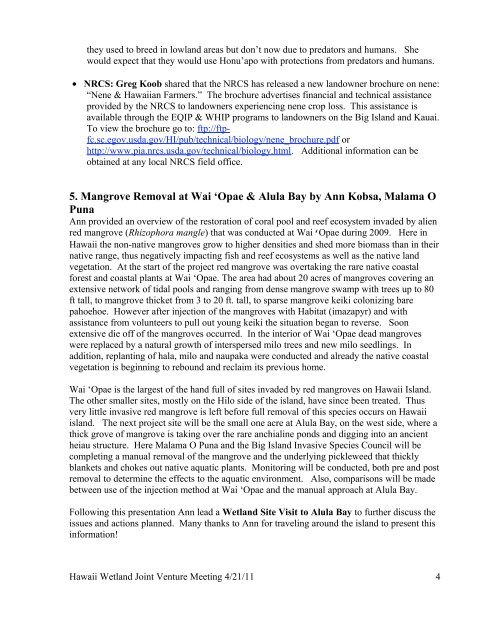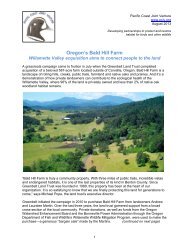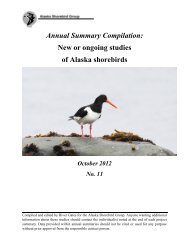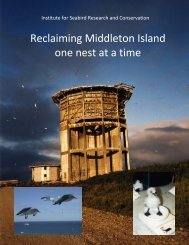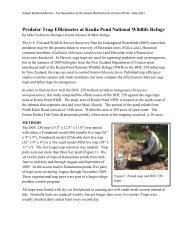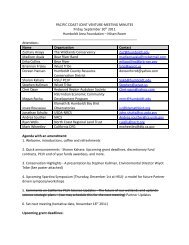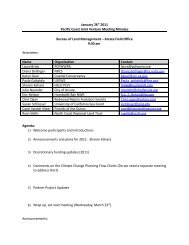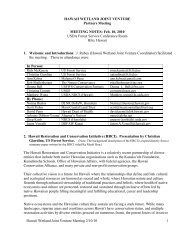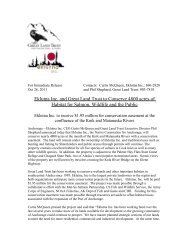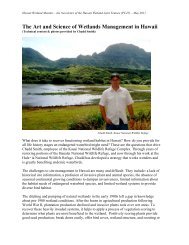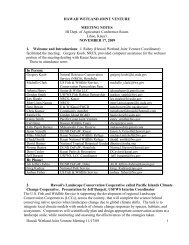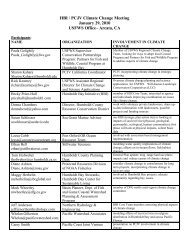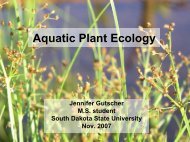hawaii wetland joint venture - Pacific Coast Joint Venture
hawaii wetland joint venture - Pacific Coast Joint Venture
hawaii wetland joint venture - Pacific Coast Joint Venture
Create successful ePaper yourself
Turn your PDF publications into a flip-book with our unique Google optimized e-Paper software.
they used to breed in lowland areas but don’t now due to predators and humans. She<br />
would expect that they would use Honu’apo with protections from predators and humans.<br />
• NRCS: Greg Koob shared that the NRCS has released a new landowner brochure on nene:<br />
“Nene & Hawaiian Farmers.” The brochure advertises financial and technical assistance<br />
provided by the NRCS to landowners experiencing nene crop loss. This assistance is<br />
available through the EQIP & WHIP programs to landowners on the Big Island and Kauai.<br />
To view the brochure go to: ftp://ftpfc.sc.egov.usda.gov/HI/pub/technical/biology/nene_brochure.pdf<br />
or<br />
http://www.pia.nrcs.usda.gov/technical/biology.html. Additional information can be<br />
obtained at any local NRCS field office.<br />
5. Mangrove Removal at Wai ‘Opae & Alula Bay by Ann Kobsa, Malama O<br />
Puna<br />
Ann provided an overview of the restoration of coral pool and reef ecosystem invaded by alien<br />
red mangrove (Rhizophora mangle) that was conducted at WaiʻOpae during 2009. Here in<br />
Hawaii the non-native mangroves grow to higher densities and shed more biomass than in their<br />
native range, thus negatively impacting fish and reef ecosystems as well as the native land<br />
vegetation. At the start of the project red mangrove was overtaking the rare native coastal<br />
forest and coastal plants at Wai ‘Opae. The area had about 20 acres of mangroves covering an<br />
extensive network of tidal pools and ranging from dense mangrove swamp with trees up to 80<br />
ft tall, to mangrove thicket from 3 to 20 ft. tall, to sparse mangrove keiki colonizing bare<br />
pahoehoe. However after injection of the mangroves with Habitat (imazapyr) and with<br />
assistance from volunteers to pull out young keiki the situation began to reverse. Soon<br />
extensive die off of the mangroves occurred. In the interior of Wai ‘Opae dead mangroves<br />
were replaced by a natural growth of interspersed milo trees and new milo seedlings. In<br />
addition, replanting of hala, milo and naupaka were conducted and already the native coastal<br />
vegetation is beginning to rebound and reclaim its previous home.<br />
Wai ‘Opae is the largest of the hand full of sites invaded by red mangroves on Hawaii Island.<br />
The other smaller sites, mostly on the Hilo side of the island, have since been treated. Thus<br />
very little invasive red mangrove is left before full removal of this species occurs on Hawaii<br />
island. The next project site will be the small one acre at Alula Bay, on the west side, where a<br />
thick grove of mangrove is taking over the rare anchialine ponds and digging into an ancient<br />
heiau structure. Here Malama O Puna and the Big Island Invasive Species Council will be<br />
completing a manual removal of the mangrove and the underlying pickleweed that thickly<br />
blankets and chokes out native aquatic plants. Monitoring will be conducted, both pre and post<br />
removal to determine the effects to the aquatic environment. Also, comparisons will be made<br />
between use of the injection method at Wai ‘Opae and the manual approach at Alula Bay.<br />
Following this presentation Ann lead a Wetland Site Visit to Alula Bay to further discuss the<br />
issues and actions planned. Many thanks to Ann for traveling around the island to present this<br />
information!<br />
Hawaii Wetland <strong>Joint</strong> <strong>Venture</strong> Meeting 4/21/11 4


